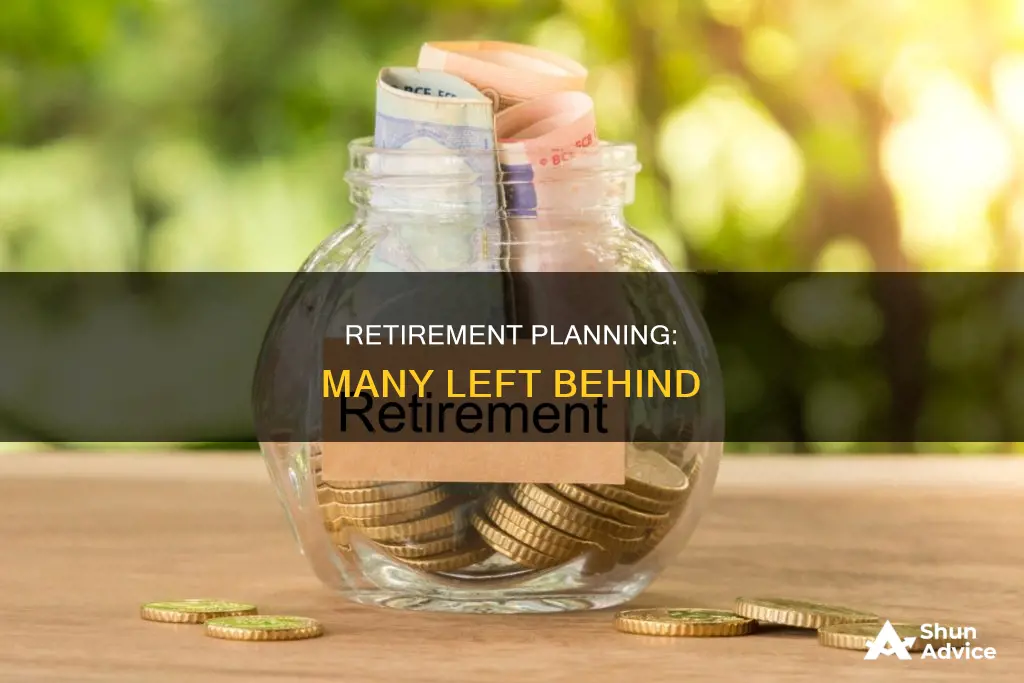
Many people don't invest in their retirement for a variety of reasons. A survey from GOBankingRates found that 55% of Americans don't invest, with many believing they don't have the money to do so. This is despite the fact that you can start investing with as little as $50 a month. A separate study by Northwestern Mutual found that 15% of Americans have no retirement savings at all, and only 10% are confident they will have enough saved for retirement. Inflation, stagnant wages, and the high cost of living are also factors that can prevent people from investing in their retirement.
| Characteristics | Values |
|---|---|
| Date of Data | 2019 |
| Percentage of Americans with no retirement savings | 15% |
| Gen X-ers (ages 39 to 54) with no retirement savings | 14% |
| Baby Boomers (ages 55 to 73) with no retirement savings | 14% |
| Americans confident they'll have enough saved for retirement | 10% |
| Americans who believe they'll run out of money in retirement | 45% |
| Americans who haven't taken action to address financial issues | 41% |
| Percentage of income to save each year | 15% |
| Percentage of Americans who aren't investing | 55% |
| Reason for not investing | Thinking they don't have enough money |
What You'll Learn

Fear of taking losses
Loss Aversion
Loss aversion is a concept in behavioural economics that refers to the phenomenon where individuals perceive a real or potential loss as psychologically or emotionally more severe than an equivalent gain. For example, the pain of losing $100 is often far greater than the joy of finding the same amount. This asymmetry in our emotional response to gains and losses can lead to irrational decision-making.
Impact on Investment Decisions
The fear of taking losses can cause investors to behave irrationally and make poor investment decisions. For example, they may hold onto a losing investment for too long, hoping it will bounce back, or they may sell winning stocks too soon. This cognitive bias is known as the disposition effect.
The overwhelming fear of loss can also lead to risk-taking behaviour, such as taking on even greater risks to try to break even or avoid locking in a loss. This can make realized losses more likely or more severe.
Overcoming the Fear
To overcome the fear of taking losses, investors should adopt a strategic asset allocation strategy and focus on making rational, research-based decisions rather than letting their emotions get the better of them. Diversifying one's portfolio by buying a broad index, such as the S&P 500, can also help mitigate the fear of loss by reducing the impact of any individual investment decision.
It is important to remember that investing is not gambling but rather involves making calculated decisions based on research and analysis. By educating oneself about the basics of investing and understanding that investing is a long-term game, one can reduce the fear of taking losses and make more confident investment decisions.
AI-Assisted Investing: The Future of Finance
You may want to see also

Lack of knowledge about investing
One common misconception is that investing requires a substantial amount of money to begin. In reality, individuals can start investing with small contributions to retirement accounts, such as an IRA or 401(k), or by opening a traditional brokerage account. However, a lack of awareness about these options may deter people from investing early on.
Additionally, understanding the stock market and making informed investment decisions can be challenging. Investors need to consider various factors, such as financial goals, time horizons, and risk tolerance. They may also need to analyze company business models, financial statements, and market trends, which can be time-consuming and complex. Without this knowledge, people may avoid investing altogether or make costly mistakes.
Furthermore, the investment landscape is constantly evolving, with new companies, technologies, and market trends emerging. Keeping up with these changes requires a commitment to continuous learning and adaptation. Those who lack the knowledge or resources to stay informed may feel left behind and reluctant to invest.
To address this lack of knowledge, individuals can seek educational resources, such as online platforms, books, or financial advisors. By improving their financial literacy and understanding of investment options, individuals can make more informed decisions and build their confidence in investing for retirement.
Robinhood: Still Relevant?
You may want to see also

People think they don't have enough money to invest
Many people don't invest in their retirement because they think they don't have enough money to do so. In fact, a survey by GOBankingRates found that 55% of non-investors cited this as their primary reason for not investing. This perception may be influenced by the common misconception that a substantial amount of cash is needed to start investing. However, this is not necessarily true, as individuals can start investing with small contributions to an IRA or 401(k) account or by opening a traditional brokerage account.
The belief that one doesn't have enough money to invest can be a result of several factors. Firstly, it may be due to a lack of financial knowledge and education. Many individuals may not understand the importance and potential benefits of investing, especially at a young age. They may also feel overwhelmed by the complexity of the financial world and unsure of where to begin. This lack of knowledge can lead to a lack of belief in their ability to achieve financial freedom through investing.
Secondly, it is worth noting that the perception of not having enough money to invest may be influenced by an individual's financial situation and circumstances. For example, individuals with high levels of debt or those facing multiple financial commitments may feel that they cannot afford to invest. Additionally, the gender pay gap may contribute to this perception, as women are more likely than men to cite insufficient income as a reason for not investing.
Furthermore, an individual's financial goals and priorities can also impact their perception of not having enough money to invest. Some people may have competing financial goals, such as saving for a house, education, or other expenses, which they view as more immediate or important than investing for retirement.
Lastly, an individual's attitude towards risk and loss may also play a role in their belief that they don't have enough money to invest. Some people may be risk-averse and fear losing money, which can deter them from investing. However, it is important to note that not investing at all can be a greater risk in the long term, especially considering the power of compound interest over time.
While it is understandable that people may think they don't have enough money to invest for retirement, it is important to recognize that investing small amounts consistently over time can lead to significant returns. Additionally, seeking financial education and advice can help individuals make informed decisions about investing and improve their financial literacy.
February: A Month for Investing?
You may want to see also

Disconnect between intention and action
While many people intend to save for retirement, there is a disconnect between this intention and the action of investing. This disconnect can be attributed to various factors, including fear of taking losses, a lack of knowledge about investing, and the perception that one needs a substantial amount of money to start investing.
For instance, a survey by GOBankingRates found that 55% of Americans do not invest because they believe they do not have enough money. However, this perception is inaccurate, as one can start investing with small contributions to an IRA or 401(k) account. Despite understanding the importance of saving for retirement, many individuals fail to translate this intention into action by taking the necessary steps to invest their money.
This disconnect is further highlighted by the findings of the Northwestern Mutual's 2019 Planning & Progress Study, which revealed that while 15% of Americans have no retirement savings, only 10% are confident that they will have enough saved for retirement. Additionally, 41% of respondents had taken no action to address the issue, indicating a gap between their intention to save and their actual behaviour.
The impact of compounding interest over time is another factor that individuals may not fully appreciate. Starting early with small, consistent investments can lead to significant growth over one's career. However, this understanding often does not translate into immediate action, as other financial priorities and a lack of financial education may take precedence.
To bridge the gap between intention and action, individuals need to educate themselves about investing and seek advice from financial advisors. By understanding the power of compound interest and the various investment options available, such as tax-advantaged retirement plans, individuals can take control of their financial future and ensure they are on track for a comfortable retirement.
Investments: Where People Put Their Money
You may want to see also

Poor financial choices
One of the most common poor financial choices is spending more than one earns. This can lead to a cycle of debt and make it difficult to put aside money for the future. Additionally, failing to be proactive about pay increases throughout one's career can result in missed opportunities to save more. Every time one gets a raise, they should increase their retirement contributions accordingly.
Another mistake is not taking advantage of employer-matched retirement plans, such as 401(k)s. This is essentially leaving free money on the table. For example, if an employer matches employee contributions up to a certain percentage, an employee who contributes less than that percentage is missing out on additional retirement funding.
Many people also make the poor financial choice of delaying saving for retirement, assuming they will have more money to put aside in the future. However, the power of compound interest means that starting early with smaller amounts can lead to a larger nest egg than starting later with larger contributions. For instance, contributing $4,500 per year over a 45-year career could result in over $1 million by retirement age, whereas waiting until 10 years before retirement and then contributing $30,000 per year would result in a much smaller sum.
Lastly, a common poor financial choice is the fear of investing due to a concern about losses. While investing does carry risk, not investing at all means missing out on the opportunity to grow one's money over time. Even small amounts invested consistently can lead to substantial gains over the long term.
Wealthy Secrets: Where the Rich Invest
You may want to see also
Frequently asked questions
According to a 2019 survey, 55% of Americans don't invest their money. A separate study by Northwestern Mutual found that 15% of Americans have no retirement savings at all.
There are several reasons why people don't invest for retirement. Some common reasons include a fear of taking losses, a lack of knowledge about investing, and the belief that they don't have enough money to invest.
It's important to start saving and investing as early as possible. People can also contribute more to their retirement accounts, take advantage of employer 401(k) matches, and make catch-up contributions if they are 50 or older.







